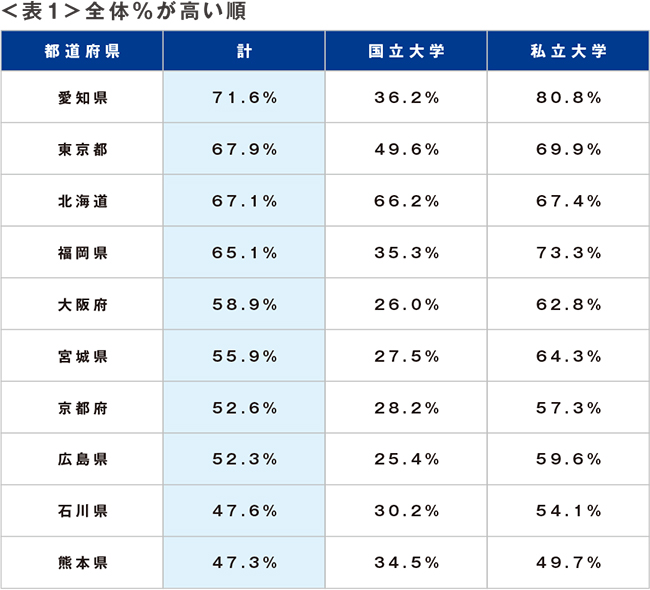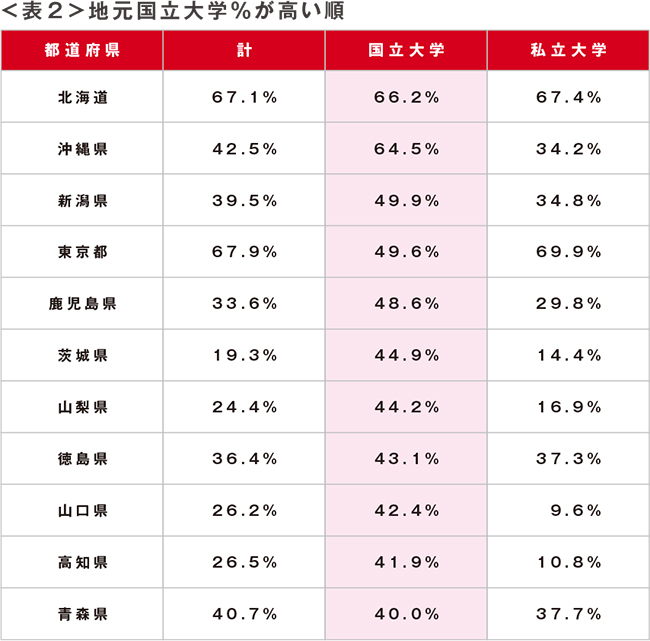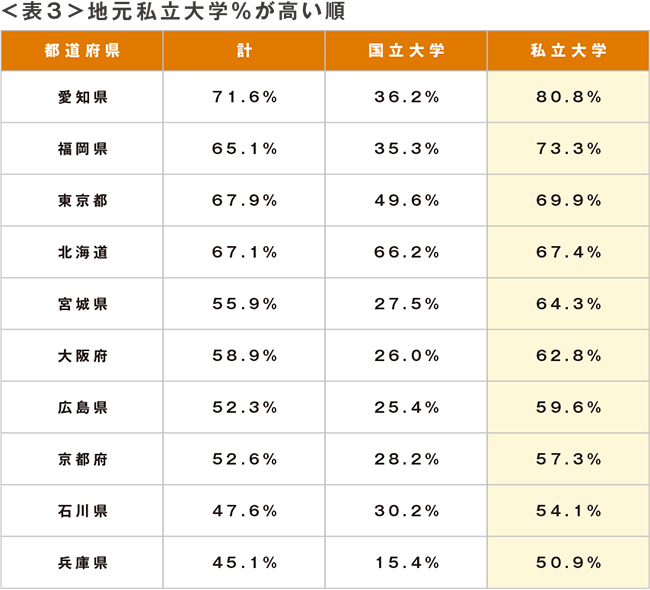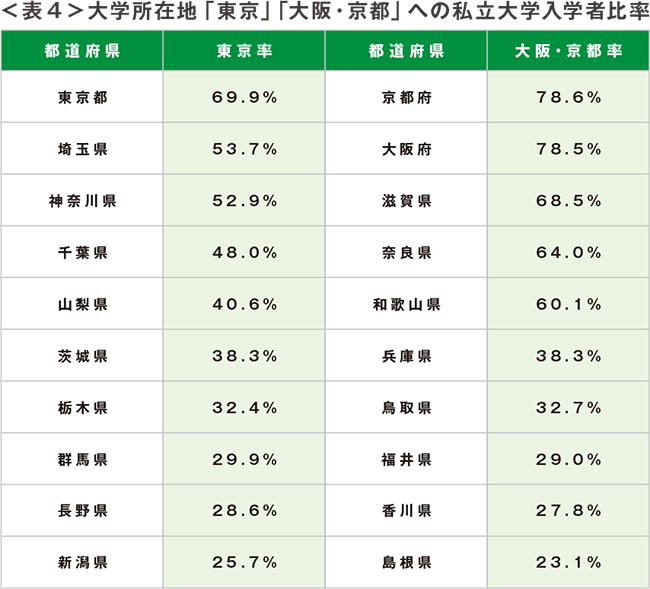Recently, due to the influence of the corona disaster, it is said that university students have a strong local orientation.However, there are cases where the number of local universities is small, so I don't think it's uniform across the country, and there are actually regional differences.Here, we will consider local orientation based on the 12 School Basic Survey (confirmed values) announced on December 21, last year.

Number of new students by prefecture where high school graduated
The School Basic Survey contains a variety of data, and very useful information can be obtained.Here, we use the “Enrollment numbers by prefecture where the high school you graduated from” is used as a material to confirm the local orientation of university students.This data is published in "Institutions of Higher Education - School Survey - Universities and Graduate Schools".In the data, the vertical column is 'location of university' and the horizontal row is 'location of high school'.And since the numbers in the table are the number of new students, they are the actual number of people who went on to university in each prefecture.Using this data, if the denominator is the total number of students enrolled in each prefecture's university from each "location of high school graduated" and the numerator is the number of students enrolled in each "university location", then the number of high schools in that prefecture is You can calculate the ratio of enrollees to each "university location" as seen from the side.
You can calculate the local university enrollment rate by calculating this enrollment ratio by "university location" and "location of high school attended" in the same prefecture.This is positioned as a tentative index that indicates local orientation, and we will look at trends, etc.The reason why I say “just in case” here is that going to a university located in Tokyo from Chiba, Saitama, or Kanagawa can be said to be going to a university in your hometown, and similarly from Nara, Hyogo, Wakayama, etc. to Osaka. Going on to a university located in Kyoto Prefecture or Kyoto Prefecture is also considered to be going on to a local school.The same is true for Miyagi, Aichi, Hiroshima, Fukuoka and neighboring prefectures.From the data, it is possible to calculate the inflow and outflow to each prefecture, but here we will look at the figures from the above calculation as the local enrollment rate.In that sense, it may be correct to say "simple local enrollment rate".
■ "General Portal for Official Statistics (e-Stat)" School Basic Survey
https://www.e-stat.go.jp/SG1/estat/NewList.do?tid=000001011528
Aichi Prefecture is No. 1 in local university enrollment rate
Looking at the simple local enrollment rate in descending order, Aichi Prefecture ranks first.In fact, 1% of students who graduated from high schools located in Aichi Prefecture and went on to universities did so (Table 71.6).Of course, there are also cases in which students from Gifu Prefecture or Mie Prefecture attended high schools in Aichi Prefecture, but I will not consider them here. 1nd place is Tokyo, 2rd place is Hokkaido, 3th place is Fukuoka prefecture, 4th place is Osaka prefecture, and prefectures with large cities are ranked high.Since the school basic survey data is divided into overall, national university, and private university enrollment rates, it is possible to compare local national university enrollment rates with local private university enrollment rates.Ishikawa Prefecture ranked 5th overall, and Kumamoto Prefecture ranked 9th overall.
![]()

When we divide the local national university enrollment rate and the local private university enrollment rate in this way, we can see a slightly different trend from the overall local enrollment rate <Table 2>.The highest rate of admission to local national universities is Hokkaido in first place and Okinawa in second place.Both are over 1%.This means that the majority of high school students who entered national universities in Hokkaido and Okinawa went on to local schools.In both Hokkaido and Okinawa prefectures, there is a physical distance to other areas, and it is thought that such a tendency can be seen.In Niigata Prefecture, Kagoshima Prefecture, Ibaraki Prefecture, Yamanashi Prefecture, Tokushima Prefecture, Yamaguchi Prefecture, Kochi Prefecture, and Aomori Prefecture, many of them are enrolled in local national universities. will be

Aichi also ranks first in local private university enrollment rate
On the other hand, looking at the local private university enrollment rate, naturally, prefectures with large cities where many private universities are located rank high. Aichi prefecture ranked first with 1%.In other words, more than 80.8% of those who graduated from high schools in Aichi Prefecture and enrolled in a private university chose a private university in their hometown of Aichi Prefecture as their destination.This is an encouraging number for a private university located in Aichi Prefecture.However, many of the large private universities in the Tokyo metropolitan and Kinki areas have off-campus examination venues in Nagoya City (Aichi Prefecture). may be necessary.The same can be said for Fukuoka Prefecture and Tokyo.
However, in Kawaijuku's university entrance examination information site Kei-Net "Looking back on the 2023 entrance examination", "In addition to the fact that the end of the corona is in sight, it is becoming easier to pass difficult universities due to the continued relaxation of competition. , This year, the desire to aim for universities in the Tokyo metropolitan and Kinki regions has increased,” he said, indicating that there is a movement to return to the Tokyo metropolitan and Kinki regions.Many students are likely to choose a local private university as their destination, but it can be understood that the environment is becoming more and more difficult to choose just because it is local.In that respect, looking at the enrollment rate of local private universities in Ishikawa Prefecture, we can see how the private universities located in Ishikawa Prefecture are doing well.

Kawaijuku's university entrance examination information site Kei-Net "Looking back on the 2023 entrance examination"
https://www.keinet.ne.jp/exam/past/review/private.html
Enrollment rate at private universities in Tokyo, Osaka and Kyoto
Many private universities are located in large cities, so there is an influx from neighboring prefectures.<Table 4> summarizes the enrollment rate of private universities located in Tokyo, Osaka, and Kyoto from each prefecture.Naturally, the proportion of prefectures in the same economic and cultural sphere is high.Among them, Tottori, Kagawa, and Shimane are prefectures with high enrollment rates at private universities located in Osaka and Kyoto prefectures, even though they are not adjacent to each other.

By the way, looking at whether to choose a private university located in Tokyo or Osaka Prefecture or Kyoto Prefecture other than a local private university, it is not simply divided into east and west.For example, in each prefecture in Kyushu, the rate of admission to private universities located in Tokyo is higher than the rate of admission to private universities located in Osaka and Kyoto.Fukuoka Prefecture is almost balanced, but slightly higher in Tokyo.
From a similar perspective, in the Shikoku and Chugoku regions, the enrollment rate at private universities in Osaka and Kyoto is higher than at private universities in Tokyo.Aichi Prefecture and Gifu Prefecture, which are geographically located in the center of east and west, have comparable enrollment rates to both prefectures.Among the three Hokuriku prefectures, Toyama has 3% private universities located in Tokyo and 16% private universities located in Osaka and Kyoto prefectures, while Ishikawa Prefecture has 14% private universities located in Tokyo and 10% private universities located in Osaka and Kyoto prefectures. , Fukui Prefecture is slightly closer to the Kinki region, with 15% of private universities located in Tokyo and 10% of private universities located in Osaka and Kyoto.However, the Hokuriku Shinkansen will open at the end of 29, so the trend in Fukui Prefecture may change in the future.
